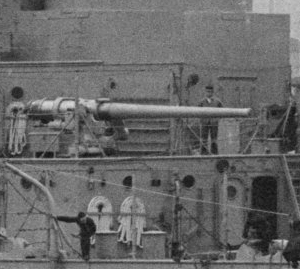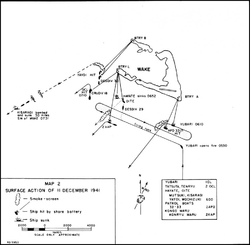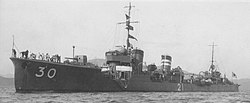Battle of Wake Island
The Battle of Wake Island was a battle during World War II. It began at the same time as the Attack on Pearl Harbor. It ended on 23 December 1941, with the surrender of the American forces to the Empire of Japan.
| Battle of Wake Island | |||||||
|---|---|---|---|---|---|---|---|
| Part of the Pacific Theater of World War II | |||||||
 A destroyed Japanese patrol boat (#33) on Wake. | |||||||
| |||||||
| Belligerents | |||||||
|
|
| ||||||
| Commanders and leaders | |||||||
|
|
| ||||||
| Strength | |||||||
|
First Attempt (December 11): 3 light cruisers 6 destroyers 2 patrol boats 2 troop transports Reinforcements arriving for Second Attempt (December 23): 2 aircraft carriers 2 heavy cruisers 2 destroyers 2,500 infantry[1] |
449 USMC personnel consisting of: 399 infantry of the 1st Marine Defense Battalion 55 det. VMF-211, 68 US Navy 5 U.S. Army personnel, Others[2] | ||||||
| Casualties and losses | |||||||
|
820 killed, 333 wounded, 1 light cruiser heavily damaged, 2 destroyers sunk, 2 transports sunk, 1 submarine sunk, 7–8 aircraft shot down, 20 aircraft damaged. See Wake Island December 1941 - Japanese aircraft shot down? - Axis History Forum Note USMC History estimates 21 aircraft shot down and 51 aircraft damaged by flak.[3] |
120 killed, 49 wounded, 2 MIA 12 aircraft [4] 433 Military and 1,104 Civilian POWS of whom 5 military (killed Jan 1942) and 98 Civilian POWS (killed Oct 1943) were killed in captivity. In addition, 15 military and 82 civilians died as POWS[3] | ||||||
It was fought on and around the atoll formed by Wake Island. It was fought by the air, land and naval forces of the Empire of Japan against those of the U.S., with Marines playing an important role on both sides.
The island was held by the Japanese for the rest of the Pacific War. The Japanese troops on the island surrendered to United States Marines on September 4, 1945.[5]
Before the attack
In January 1941, the United States Navy built a military base on the atoll. On 19 August, the first troops were sent there. They were from the 1st Marine Defense Battalion.[6] There were 450 officers and men. They were led by Major James P.S. Devereux. Also on the island were 68 U.S. Navy staff and about 1,221 civilian workers.


The Marines were armed with six 5 in (127mm)/51 cal pieces. These came from the battleship USS Texas. There were also twelve 3 in (76 mm)/50 cal anti-aircraft guns, eighteen .50 in (12.7 mm) Browning heavy machine guns, and thirty M1917 Browning machine guns.
On 8 December, just hours after the attack on Pearl Harbor, Japanese Mitsubishi G3M3 bombers attacked Wake Island. They destroyed 8 of the 12 F4F-3 Wildcat fighter aircraft belonging to Marine Corps fighter squadron VMF-211.
First landing attempt
Early on the morning of 11 December, the troops, with the four remaining Wildcats, stopped the first Japanese landing attempt.
The U.S. Marines fired at the Japanese ships with their six 5 in 127mm coastal artillery guns. They sunk Hayate at a distance of 4,000 yd (3,700 m). Yubari was hit 11 times. The four Wildcats sunk another destroyer, Kisaragi, by dropping a bomb on her stern.
The Japanese force pulled back before landing. This was the first Japanese defeat of the war.
Japanese air attacks on the Wake troops continued, without new supplies for the Americans. The Japanese Navy sent two aircraft carriers (Sōryū and Hiryū) to support the second landing attempt.
USN relief attempt
The attempt to help Wake Island was led by Admiral Frank Fletcher's Task Force 11 (TF 11) and supported Admiral Wilson Brown’s TF 14. The carrier Saratoga, the fleet oiler Neches, the seaplane tender Tangier, the heavy cruisers Astoria, Minneapolis, and San Francisco, and 10 destroyers were sent to Wake.
The convoy carried the 4th Marine Defense Battalion and the VMF-221 fighter squadron. They had Brewster F2A-3 Buffalo fighters. They had 9,000 5 in (127mm) rounds, 12,000 3 in (76 mm) rounds, and 3,000,000 .50 in (12.7 mm) rounds. They also had a large amount of ammunition for mortars.
TF 14—with the fleet carrier Lexington, three heavy cruisers, eight destroyers, and an oiler—was sent to attack the Marshall Islands. The goal was to take Japanese attention away from Wake Island.
At 21:00 on 22 December, after learning that two IJN carriers were near Wake Island, TF 11 was ordered to return to Pearl Harbor. The US were afraid that the US would lose ships[7]
Second assault

{211 for "Squadron 211"; F for "Fighter"; 11 for 11th plane}
The second Japanese invasion force came on 23 December. It was mostly the same ships from the first attempt plus the carriers Hiryu and Soryu, and 1,500 Japanese marines. The landings began at 02:35 after a preliminary bombing.
After a full night and morning of fighting, the Wake troops surrendered to the Japanese.
The U.S. Marines lost 47 killed during the 15-day battle. Japanese losses were recorded at between 700 and 900 killed, with at least 300 more wounded.[3] Two destroyers were lost in the first invasion attempt and 28 aircraft were shot down or damaged.
Japanese occupation
The Japanese built strong defences on Wake Island. The American captives were forced to build bunkers and fortifications on Wake. The Japanese brought in an 8-inch (200 mm) naval artillery gun.
The U.S. Navy used submarines to prevent any Japanese ships from getting to Wake. The Japanese troops starved. On 24 February 1942, aircraft from the carrier Enterprise attacked the Japanese troops on Wake Island.
U.S. forces bombed the island from 1942 until Japan’s surrender in 1945. On 24 July 1943, B-24 Liberators bombed Wake Island.
War crimes
On 5 October 1943, American naval aircraft from Yorktown raided Wake. Two days later, Rear Admiral Shigematsu Sakaibara ordered the execution of the 98 captured American workers. They were blindfolded and executed with a machine gun.
On 4 September 1945, the remaining Japanese troops surrendered to a U.S. Marines.
Admiral Sakaibara and Lieutenant-Commander Tachibana were sentenced to death for the massacre.
Battle Of Wake Island Media
References
- ↑ Naval and air personnel not included.
- ↑ A significant number of civilian construction workers volunteered to fight also.
- ↑ 3.0 3.1 3.2 "The Defense of Wake: Appendix III". www.ibiblio.org.
- ↑ Martin Gilbert, the Second World war (1989) pg 282
- ↑ "War in the Pacific NHP: Liberation - Guam Remembers". Archived from the original on 2012-12-17. Retrieved 2013-12-12.
- ↑ "1st Marine Defense Battalion".
- ↑ Lundstrom, John B. The First Team: Pacific Naval Air Combat from Pearl Harbor to Midway. Annapolis, Maryland: Naval Institute Press, 1990. ISBN 978-1-59114-471-7.









